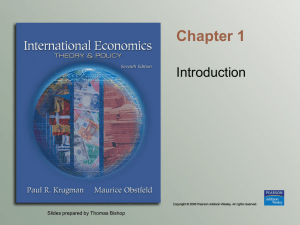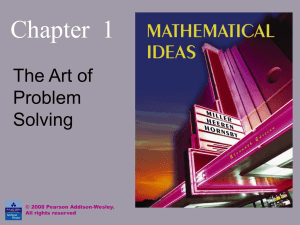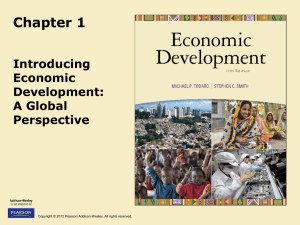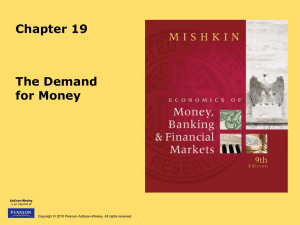Chapter 3
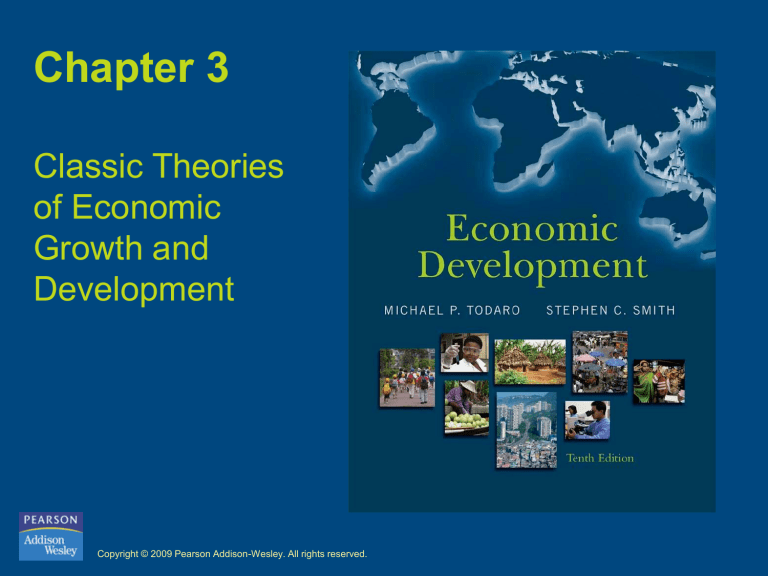
Chapter 3
Classic Theories of Economic
Growth and
Development
Copyright © 2009 Pearson Addison-Wesley. All rights reserved.
Class Theories of Economic
Development – Four Approaches
• Structural change model
– Linear stages of growth
– Saving-investment
– Rural-urban migration
• Neocolonial dependence theory
– Dependence: Center vs. Periphery
– False Paradigm
• Neoclassical theory
– Market friendly approach
– Dualistic approach
– Public choice approach
Copyright © 2009 Pearson Addison-Wesley. All rights reserved.
3-2
Rostow’s Linear-Stages Model
1.
Traditional society
2.
Pre-condition to take-off
3.
Take-off
4.
Drive to maturity
5.
Age of high mass consumption
Copyright © 2009 Pearson Addison-Wesley. All rights reserved.
3-3
Rostow’s Linear-Stages Model
1.
Traditional society: slow economic and population growth
2.
Pre-condition to take-off: development of institutions, organizations, and infrastructure
3.
Take-off: large investment in selected industry (10 to 15% of GDP)
3-4 Copyright © 2009 Pearson Addison-Wesley. All rights reserved.
Rostow’s Linear-Stages Model
4.
Drive to maturity: sustained growth of the industry and economy
5.
Age of high mass consumption: production of consumer goods and services to serve an affluent society
3-5 Copyright © 2009 Pearson Addison-Wesley. All rights reserved.
Rostow’s Linear-Stages Model
GDP Growth
Economic Growth
Post Take-off
Take-off
Pre Take-off t
1
Copyright © 2009 Pearson Addison-Wesley. All rights reserved.
t
2 Time
3-6
Harrod-Domar Growth Model
S = sY S=Saving; Y=Real GDP; s=Saving Ratio
I = ΔK I=Investment; ΔK=Capital Accumulation
S = I Saving-Investment identity
Define the Marginal Capital-Output Ratio as k = ΔK/ΔY
Write ΔK = kΔY or I = kΔY
From S = I, write sY = kΔY or
ΔY/Y = s/k
Copyright © 2009 Pearson Addison-Wesley. All rights reserved.
3-7
Harrod-Domar Growth Model
The source of growth is saving and investment in production of goods and services . Accordingly,
GDP growth rate = s/k s = national saving ratio; k = marginal capital-output ratio
If s=6% and k=3, then GDP growth rate=2%. Given k=3, to raise growth rate to 4%, we need to increase the saving ratio from 6% to 12% with 6% of foreign saving
Copyright © 2009 Pearson Addison-Wesley. All rights reserved.
3-8
Criticism of Investment Models
• Many LDCs have not been able to take-off or achieve maturity despite massive foreign investment
• Many nations have neglected the development of institutions, organizations, and infrastructure required for industrialization
3-9 Copyright © 2009 Pearson Addison-Wesley. All rights reserved.
The Lewis Development Model
• Rural agricultural sector
– Low or even zero Marginal Product of Labor so that labor is a redundant factor and wage rate is at the subsistence level
• Urban industrial sector
– Rising demand for unskilled labor to be trained for industrial growth results in greater employment and more profits and higher wages
• Rural-Urban migration
– To find jobs and earn higher wages
Copyright © 2009 Pearson Addison-Wesley. All rights reserved.
3-10
Demand for Labor
Wage
R: Rural
W: Wage
U: Urban
E: Employment
D: Labor Demand S: Labor Supply
W
U
Profit
W
R
Wage
E
1
E
2
S
R
D
U1
D
U2
Employment
Investment in urban areas increases the demand and employment for rural labor.
Copyright © 2009 Pearson Addison-Wesley. All rights reserved.
3-11
Criticisms of Lewis Model
• Industrial technology is generally capital intensive/labor-saving. Hence, the demand for unskilled rural labor would not increase employment
• Industrialization must be supported by agricultural development to supply an ever-increasing supply of food items and raw materials
Copyright © 2009 Pearson Addison-Wesley. All rights reserved.
3-12
Demand for Labor
Wage
No increase in employment when technology is labor saving
Profit
W
U
W
R Wage
D
U2
E
1
= E
2
S
R
D
U1
Employment
Copyright © 2009 Pearson Addison-Wesley. All rights reserved.
3-13
Neocolonial Dependence Model
• MDCs form the “center” of global economic relations and technological advancement
• LDCs serving as the “periphery” are dominated by:
– unequal trade and finance relations
– domestic politico-economic elite
– multinational corporations
Under these conditions economic development is impossible
Copyright © 2009 Pearson Addison-Wesley. All rights reserved.
3-14
Neocolonial Dependence Model
African LDC
S
Asian LDC
S American
MDCs
European
Other
MDCs
MDCs
Latin American LDC
S
Copyright © 2009 Pearson Addison-Wesley. All rights reserved.
3-15
False-Paradigm Model
• Economic development relies heavily on funds from international donor agencies such as the
World Bank and IMF
• The policy of these agencies is to support urban industrial growth and impose capitalistic austerity measures
• They reinforce the pattern of “dependent development”
Copyright © 2009 Pearson Addison-Wesley. All rights reserved.
3-16
Dualistic Development Model
• Structural transformation models create a
“dualistic” pattern of development, resulting in an ever-increasing degree of economic inequality both nationally and internationally:
– urban vs. rural
– industrial vs. agricultural
– modern vs. traditional
– rich vs. poor
Copyright © 2009 Pearson Addison-Wesley. All rights reserved.
3-17
Approaches to Development
• Free-market approach: rely of the allocation role of markets and limited government involvement in economics. But, there are several areas in which markets fail to achieve efficient outcomes:
– income distribution
– public goods
– externalities
– market power
Copyright © 2009 Pearson Addison-Wesley. All rights reserved.
3-18
Approaches to Development
• Market-friendly approach: improve market operation through “nonselective” interventions such as
– income redistribution system
– investment in social and human capital
– environmental protection policy
– anti-trust laws
Copyright © 2009 Pearson Addison-Wesley. All rights reserved.
3-19
Approaches to Development
• Public-choice approach: public officials and bureaucrats in the position of authority are
“ rent-seeking ” citizens acting on self-interest rather than public-interest
• Need a system of checks and balances to monitor the behavior of public officials and bureaucrats
• Need a democratic system to let people choose public officials and bureaucrats for limited duration of authority
Copyright © 2009 Pearson Addison-Wesley. All rights reserved.
3-20
Appendix 3.1: Components of
Economic Growth
• Capital Formation
– Physical capital formation: investment in tools, equipment, machinery, buildings
– Social capital formation: investment in roads, dams, airports, railroads, bridges
– Human capital formation: investment in education, training, health, nutrition
– Political capital formation: investment is creating a secular and democratic government and free mass media
Copyright © 2009 Pearson Addison-Wesley. All rights reserved.
3-21
Determinants of Economic
Growth
• Physical Capital Formation
– Increase in the amount of physical capital per unit of labor
Copyright © 2009 Pearson Addison-Wesley. All rights reserved.
3-22
Determinants of Economic
Growth
• Technological Advancement
– Increase factor productivity (labor, land, capital)
Copyright © 2009 Pearson Addison-Wesley. All rights reserved.
3-23
Production Possibilities Curve
•
Maximum quantities of two good and services the economy can produce, assuming:
– full employment / efficiency
– fixed resources
– constant technology
Copyright © 2009 Pearson Addison-Wesley. All rights reserved.
3-24
PPC Schedule
Combination
Radios
Rice
A B
100 90
0 40
C
50
80
E
0
100
Copyright © 2009 Pearson Addison-Wesley. All rights reserved.
3-25
PPC Graph
Radios
100
90
A
50
F
B
Combinations A, B, C, and E are attainable
Combination D is unattainable given resources and technology
Combination F is attainable, but inefficient
D
C
40
E
80 100
Rice
Copyright © 2009 Pearson Addison-Wesley. All rights reserved.
3-26
Economic Growth
Radios
A
100
90
50
B
C
Combination D becomes available with more resources and better technology
D
40 80 100
E
Rice
Copyright © 2009 Pearson Addison-Wesley. All rights reserved.
3-27
Economic Improvement
Radios
100
90
A
50
Combinations G (or B or C) becomes efficient with more employment and/or improved efficiency
F
B
G
C
40
E
80 100
Rice
Copyright © 2009 Pearson Addison-Wesley. All rights reserved.
3-28
Technological Advancement
Neutral: proportional increase in the supply of Rice and Radios
Radios
Copyright © 2009 Pearson Addison-Wesley. All rights reserved.
Rice
3-29
Technological Advancement
Capital augmenting: greater increase in the supply of Radios
Radios
Copyright © 2009 Pearson Addison-Wesley. All rights reserved.
Rice
3-30
Technological Advancement
Radios
Labor augmenting: greater increase in the supply of Rice
Copyright © 2009 Pearson Addison-Wesley. All rights reserved.
Rice
3-31
Technological Advancement
Radios
Advancement only in agricultural production
Copyright © 2009 Pearson Addison-Wesley. All rights reserved.
Rice
3-32
Technological Advancement
Radios Advancement only in industrial production
Copyright © 2009 Pearson Addison-Wesley. All rights reserved.
Rice
3-33
Factor Accumulation Accounts for
Only a Fraction of Growth
Copyright © 2009 Pearson Addison-Wesley. All rights reserved.
3-34



